
282
PARTISAN REVIEW
inclined
to
fawn over him. Unlikely as it seemed, this long-haired loud–
mouth showed every sign of having the potential to become an artist
worthy of comparison with the greatest dancemakers of the twentieth
century, George Balanchine very much included.
From then on, I made a point of seeing the Mark Morris Dance Group
whenever it came
to
New York. Unfortunately, there weren't all that many
performances to see. The company soon moved to Brussels, and for the next
few seasons its American appearances were infrequent. Even after Morris
and his dancers returned to this country, they spent most of their time on
the road, and their New York seasons tended to be short.
In
addition, they
rarely performed older works-Morris preferred
to
show new dances–
making it impossible to get to know their repertory more than superficially.
This lack of familiarity with Morris's work is a greater obstacle to
comprehension than is commonly understood. Balanchine was once
widely regarded as a "difficult" artist, even by ostensibly knowledgeable
critics; not until New York City Ballet began giving extended seasons of
repertory at City Center did it become possible for serious dancegoers
to become comfortable with such bristlingly complex ballets as "Con–
certo Barocco" or "The Four Temperaments." Edward Gorey, for
instance, attended each and every performance the company gave
between 1957 and 1982, later writing a delightfully knowing book
called
The Lavender Leotard; or, Going a Lot to the New York City
Ballet.
I never went to City Ballet that often, even in my first hot flush
of discovery, but within a few seasons I had gone often enough to see
most of Balanchine's major ballets a half-dozen times or more, and the
more I saw them, the more I saw in them. With Mark Morris, by con–
trast, what you saw the first time was what you got, and all you got.
By the mid-1990S, I was regularly covering Morris's New York open–
ings, and my feelings about his work were more or less the same as they
had been in 1988 . Though he remained the only choreographer under
the age of fifty who looked like a major artist in the making, some of
his dances I thought successful, others less so, several not good at all,
and none unequivocally great. As I wrote in a 1994 essay:
Those who find Morris irritating also find it impossible to ignore
him. I find him extremely irritating, and it would never occur
to
me
to ignore him. There is no young choreographer I admire more. But,
then, Morris isn't so young anymore. By the time he was 37, George
Balanchine had made "Apollo" and "Serenade" and "Concerto
Barocco."
If
the comparison seems unfair-these are, after all, three
of the transcendent masterpieces of 20th-century dance-it is worth


